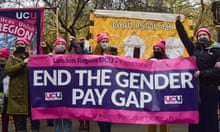Almost half of the companies included on a list of businesses feted as the best places to work as a woman in the UK have a gender pay gap higher than the national average, exclusive Guardian analysis has revealed.
Of the subsidiaries of companies included on the Times Top 50 Employers for Women list in 2017, more than nine in 10 pay women less than they pay men on average, with almost half of the companies reporting a gender pay gap greater than 18.4% – the national average as calculated by the Office of National Statistics.
Analysis also shows that more than four in 10 FTSE 100 companies, based on subsidiaries which were required to report, have a gender pay gap higher than the national average and nine in 10 report they pay women less than men on average.
The figures were revealed as businesses published the difference between what they pay men and women for the first time on 4 April. More than 10,000 companies reported figures with almost 300 subsidiaries of FTSE 100 companies among those reporting.
Sam Smethers, chief executive of the Fawcett Society said the gender pay gap was a complex indicator of inequality in the workplace. “Even good employers can have significant pay gaps,” she said. “What matters is their action plan to tackle it and deal with any inequality they find.”
A Pearson subsidiary reported the biggest gender pay gap among FTSE 100 companies. Pearson Shared Services, a technology and operations firm, reported a median hourly gap of 60% meaning that on average a woman at the company is paid 40p for every £1 earned by a man. Women also make up 18% of the top earners, despite accounting for a third of the workforce.
Four out of five Pearson subsidiaries reported a gender pay gap and the publisher reported an average gap of 15% across the entire company.
Quick GuideWhat is the gender pay gap, and what must UK companies report?
Show
What is the gender pay gap?
The gender pay gap is the difference between the average hourly earnings of men and women. The figure is expressed as a proportion of men’s earnings. According to the ONS, the gap between what UK male and female workers earn – based on median hourly earnings for all workers – was 17.9% in April 2018, down from 18.4% in April 2017. Data in 2018 showed that men were paid more than women in 7,795 out of 10,016 companies and public bodies in Britain.
What is being published?
All companies and some public sector bodies in Great Britain, except Northern Ireland, with more than 250 employees had to report their gender pay gap to the Government Equalities Office for the first time by by 4 April 2018. The second year of gender pay gap reports - and the first indicator of how public bodies and companies are performing - must be filed by April 2019
What’s the difference between the mean and the median figures?
Commonly known as the average, the mean is calculated by adding up the wages of all employees and dividing that figure by the number of employees. The mean gender pay gap is the difference between mean male pay and mean female pay.
The median gap is the difference between the employee in the middle of the range of male wages and the employee in the middle of the range of female wages. Typically the median is the more representative figure, because the mean can be skewed by a handful of highly paid employees.
What will happen if companies don’t report?
The Equality and Human Rights Commission (EHRC) said that, while it would approach employers informally at first if they failed to publish figures by the deadline, businesses could ultimately face “unlimited fines and convictions”. However, information published following a freedom of information request by the Guardian showed that no companies have been fined to date despite hundreds failing to accurately file their gender pay gap figures on time.
Global advertising agency WPP also reported large differences in what they pay men and women on average. The company filed figures for 19 of its subsidiaries, almost half of which had a pay gap greater than the national average of 18.4%. It reported a gap of 14.6% across the company, excluding associates.
One woman working in advertising told the Guardian she was paid 20% less than a male counterpart on her direct team, but had encountered defensiveness when she had tried to address the issue.
“Women are afraid to speak up because they’re dismissed or made to feel silly. I spoke up, and got given advice by two separate senior people to stop talking about the gender pay gap,” she said.
Most large companies, including many on the Times Top 50 and FTSE 100, reported multiple subsidiaries with more than 250 employees. The Guardian’s analysis is based on the subsidiaries with the largest reported median hourly pay gap as of 6 April. 13 FTSE 100 companies did not publish figures as they do not have enough UK-based employees to be required to report their pay gap.
Other FTSE companies with subsidiaries which reported gaps of more than 45% were Anglo American, Tui, St James’s Place, SSE and easyJet.
Mining giant Anglo American reported a median pay gap of 48.5%, and revealed that women account for only 14% of top-earners. In the company’s report it committed to a number of measures including a 33% quota of women in the company’s executive committee.
Tui – which reported gender pay gaps of 47.3%, 31.4% and 2.6% in three subsidiaries – said it was committed to change, while easyJet – whose chief executive took a pay cut to match the outgoing female CEO in January – has launched a recruitment drive to hire more female pilots.
Management services company St James’s Place, with a gap of 46.4%, said narrowing the gap was a “key objective”, while SSE (– which reported a 19.3% gap compared to subsidiary Tesgl Limited’s 45.5% – said it had implemented a range of measures including partnering with Teach First to encourage school girls into Stem subjects.
Among the companies with the highest pay gaps on the Times Top 50 Employers for Women list are subsidiaries of major banks – JP Morgan Ltd (54%), Morgan Stanley Employment Services UK (46.2%), Barclays Bank Plc (43.5%) and Lloyds Bank Plc (42.7%).
Companies on the Times list are self-nominated by submitting a 5,000 word report which is then “marked against a framework of best practice”.
Five JP Morgan subsidiaries reported an average gender pay gap worse than the national average. In its gender pay gap report the company laid out a range on policies in place including recruitment and targets at VP and ED level.
Morgan Stanley said it was proactively increasing the number of women in senior roles and was “nurturing the future pipeline”. Barclays said it had a longstanding commitment to improving gender diversity, while Lloyds said it aimed to have women in 40% of all senior roles by 2020.
A spokeswoman for Business in the Community, which compiles the Times’ list, said it did not specifically ask about the size of a company’s gender pay gap, but focused on the companies’ actions.
“Companies in the Top 50 have proven they are taking action to address inequalities such as fewer women going into certain industries, lower pay due to working part-time, or having taken a career break, as well as unconscious bias and discrimination, personal choice and corporate culture,” said a spokeswoman. “Of course, we want to see impact and culture change, and we would expect to see everyone’s gender pay gap improve over time.”
Karen Gill, co-founder of Everywoman, which aims to advance women in business, said companies needed to take bolder action.
“They are taking steps and they are making progress, but the things that need to change are not quick fixes,” she said. “That doesn’t mean they are not good places to work – or at least better than others – it just means they are not going fast enough.”
If companies failed to take action, they would face the consequences, she added.
“Women are going to use this tool. It’s a talent game, and they won’t get the best talent unless they deal with it.”
Additional reporting Joseph Scott Davies and Giacomo Boscaini-Gilroy










